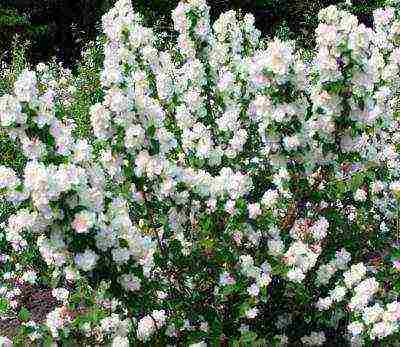Content
It is difficult to imagine the roadsides of our country, and the streets of cities and villages, without poplars. These trees can rightfully be called the masters of our streets. The pyramidal poplar is striking in its slenderness. In the description of the poplar, they certainly pay attention to the unique shape of its crown - it is columnar or narrow. If the tree is not cut, it can reach a height of 30 m. The triangular leaves of a dark green color open by the end of April, around this time the tree blooms. Such poplar grows very quickly. In the middle of autumn, the tree loses its leaves. It is frost-resistant, but may suffer from frost. Pyramidal poplar is the only plant that enriches the air with oxygen all day long - photosynthesis in its leaves goes on even in the dark at night.
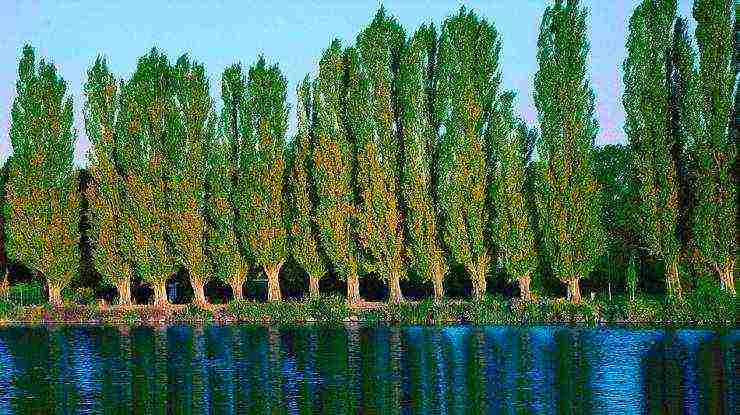
Poplar pyramidal
Poplar is so widespread in our area that it has long been perceived as a primordial Slavic tree. It is believed that the tree first appeared in Asia Minor, Afghanistan and the Himalayas. A very large amount of it is concentrated in Italy, for which the poplar is often called "Italian" or "Lombard".
Mainly male varieties of poplar are cultivated. The lifespan of a tree depends on the living conditions. It is planted in various ways - both as a single plant, and in a group when creating rows and alleys.
Care
When creating a row of pyramidal poplars, the distance between trees should be 1.5x3 m or 2.5x4 m. The poplar has a long and wide root system, and, accordingly, the hole when planting should be up to 1 meter deep.
Poplar grows well on fertile soils, which include turf, peat and sand. If the soil is heavy, a drainage layer is placed on the bottom of the hole, one third of the hole is filled with it. Photophilous - sunny places are chosen for poplar alleys.
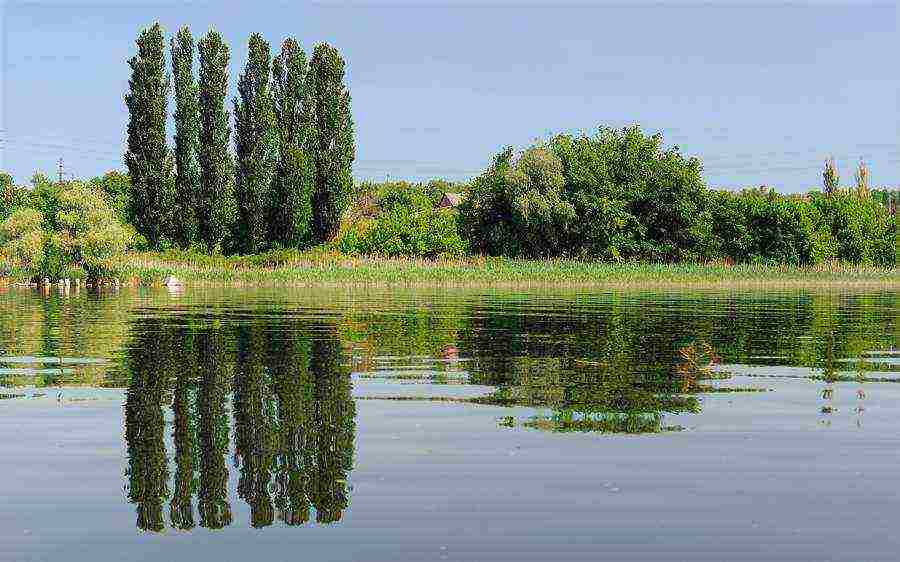
Of the fertilizers, poplar prefers nitrogen fertilizers. Planting, bring nitroammofosku, counting 100 g per square meter.
Water the tree abundantly. Watering one plant takes about 25 liters of water. In the first year after planting, watered 2-3 times a month, watering is also necessary during a drought period.
During the first years of the seedling's life, it is recommended to loosen the peri-stem circle after each watering in order to retain more moisture. In the spring, after the snow melts, this area is necessarily pierced to a depth of 15 centimeters. The same procedure is carried out in the fall, preparing the plant for winter. Trees older than 6 years do not need loosening; in this case, the soil near the trunk can be sown with lawn grass.
Immediately after planting and sufficient watering, the seedling is mulched with peat or sawdust.
Poplar tolerates winter colds and frosts well and does not need special preparation for the cold season.
It is recommended to cut and prune these trees annually, starting from the first years of growth. After pruning, the wounds are treated with a special garden lubricant. According to the rules of pruning, two-thirds of the length of the branches are cut off, a maximum of 20 cm remains on the tree. It is important to keep track of the shape of the crown - it must be even.
The best time for pruning is winter or early spring. It must be carried out before the juices in the tissues of the plant begin to move.
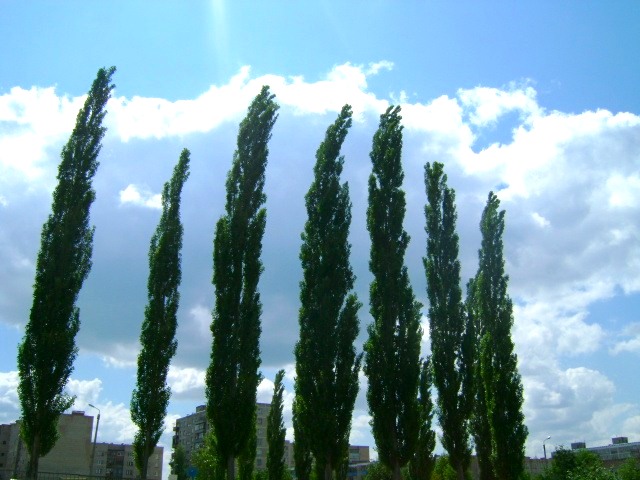
In order to rejuvenate the plant, its top is cut off (about one tenth of the height). At the end of the pruning procedure, the tree is fed, watered and ground near the trunk is dug up.
An armful of shoots grows quickly near the stump, which remains from a tree that is completely cut off. It can also be trimmed and shaped in this way.
Breeding rules
There are two ways of propagation of these trees - vegetative and through sowing seeds. To grow poplar, in practice, the vegetative method is most often used.
Poplar twigs root quite easily without any extra effort. It is enough just to put them in a container of water or stick them into moistened soil. As a cuttings, one-year-old shoots of a tree are taken, which are cut off before the intensive movement of juices in the tissues of the trunk begins (in extreme cases, this can be done when the buds begin to crack). The shoots you need are easy to recognize: they are the thinnest branches from the ends of larger branches or from the top of the trunk. The buds and places of last year's leaves are quite noticeable on them. The length of such a shoot is, as a rule, up to 1 meter (the shoots from the lower part of the crown are short). Parts of old branches are not used as cuttings - they may no longer have buds suitable for the development of a new plant.
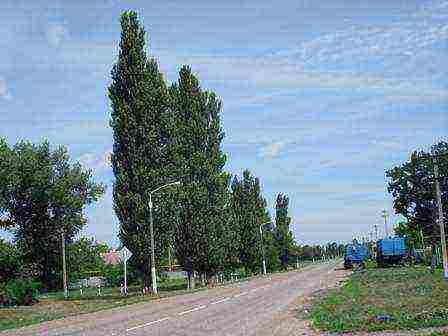
Spring and autumn are considered the best time for planting seedlings. It is then that the tree takes root most easily. The planting of poplar plantings begins as soon as the snow melts, and is carried out until the new leaves unfold to half. In autumn, it is advisable to plant young trees when the leaves mostly turn yellow, and finish after light frosts.
After the young one-year-old branches have been cut, they are divided into cuttings 15-20 cm long. It is important to make sure that there are several live buds left on each cutting (preferably on the upper part of the cutting). Cuttings are planted near the moistened soil, top to top (they pay special attention to this), and in such a way that about a quarter of the cuttings with buds remain above the ground. The distance between the cuttings should be 10-15 cm. The planted cuttings require regular watering. With careful care of the buds, new shoots are formed and rapidly grow up to 15 cm in height. Thus, by the beginning of the autumn planting, seedlings up to one meter high are obtained.
As you can see, the pyramidal poplar is a tree that is completely unpretentious to care for; you do not need to create any special conditions for it. That is why this seemingly ordinary tree has become an indispensable decoration of our streets and parks.
This slender tree with a columnar and narrow crown can reach a height of up to 30 meters, unless, of course, timely pruning is carried out. The dark green, triangular leaves open in April, sometimes at the same time as the flowers. This poplar grows rapidly. Leaf fall begins in late October - early November. Although it can suffer from frost, it is able to restore the crown. It perfectly cleans the air and can become a real decoration of the garden.
Landing
If you decide to plant a row of pyramidal poplars, then the distance between the plants should be 1.5x3 meters or 2.5x4 meters.
The pit should be up to 1 meter deep, since the root system of poplars is deep and extensive.
The root collar is at soil level or buried by 1.5-2 cm.
Soil mixture - sod land, peat sand in a ratio of 3: 2: 2.
The pyramidal poplar is very light-requiring. Pick a sunny spot.
Planting is carried out in the spring. If planted in the fall, the plant may not take root.
Drainage is required on heavy soils. They fill 1/3 of the depth of the pit.
Top dressing
When planting, nitroammofoska or complex fertilizer is applied at the rate of 100 g per square meter.
Watering
Watering should be plentiful so that the soil is saturated with moisture to the root depth - approximately 25 liters per plant.
In the first year of planting, watered 2-3 times a month, as well as in the dry season.
Loosening and mulching
To retain moisture, the trunks are loosened after each watering.
In spring and autumn, bayonets are required to a depth of 10-15 centimeters.
After 6 years, it is no longer necessary to loosen, and the trunks can be sown with a lawn.
You can mulch with humus, peat or sawdust immediately after planting and watering.
Preparing for winter
No special preparation is needed, since the poplar is frost-hardy.
Haircut and trim
Poplars tolerate cutting and pruning well, easily restore the crown.
After trimming, the wounds with a diameter of 2.5 cm are covered with garden putty.
Pruning begins at an early age of the plant and is carried out annually.
Cut off 2/3 of the length of the shoot, leaving 10-20 cm on the tree, while making sure that the shape of the crown is even.
Heavy pruning is carried out in winter or early spring - before the start of sap flow.
A powerful growth is formed from the stump, which also needs to be formed.
If you want to rejuvenate the plant, then the top is cut off - about 10% of the height.
After a strong pruning, fertilizers are applied, the trunk circle is regularly watered and loosened.
Poplar is a member of the Willow family, and belongs to the genus of fast-growing trees, the number of which, according to some sources, is about one hundred and ten million years. By crossing some species, separate varieties of poplar, the so-called hybrids, were obtained. Due to its high growth rate, this plant is often grown in energy forests and its own summer cottages.
Poplar bears fruits in the form of a small capsule with small seeds. The seeds have a peculiar bundle of hairs, due to which, when the seeds spread, poplar fluff can be observed. Poplars belong to the category of long-livers that can grow for three hundred years. Already mature trees have a dark shade of the trunk and growths at the base of the roots.
The crown of the poplar is wide with branches spread out on the sides. The buds are covered with resin, and they are shaped like a cone or a large egg. The leaves are large, located on long petioles. The shape of the leaves is often triangular, sometimes rhombic. During the flowering period, inflorescences begin to appear, mainly on hanging long earrings.
Flowering begins in mid-spring, after which leaves form. The fruits themselves ripen in early summer. Poplar grows best in Siberia, Central Asia and the European part of our country. Poplar can be found in parks and deciduous forests. For independent propagation of the tree, it is recommended to plant both male and female specimens.
The main types of poplar in Russia
In the strip of coniferous and deciduous forests, such rot-resistant crops as: black poplar, Berlin, gray, white, fragrant, balsamic and Petrovsky poplar are often planted. In the steppe zone, poplar types such as white, pyramidal, Canadian, laurel and Bolleana are more common. Breeders have developed many different hybrid poplar species for rapid growth, but they all do not tolerate severe frosts.
Some species of this plant are used in industry and they are grown in special plots. Such rocks are necessary in order to obtain biofuel, among them such species are used as: Gulliver, Kaliberdzhinsky, Tronko and Arrowhead. Since the beginning of the two thousandth year, more than ten poplar species have been brought to the territory of the Russian Federation, which were selectively bred by breeders from Armenia.
These specimens are unique due to their accelerated growth, therefore, in the shortest possible time, the poplar can grow up to fourteen meters in height, while the trunk diameter will be about twenty centimeters. And the weight of such a tree will be about one hundred kilograms.
Consider the main varieties of poplar
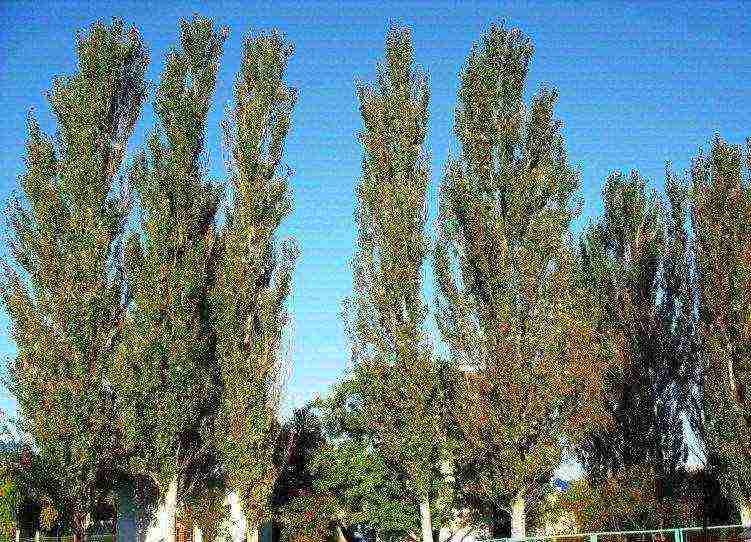
- Poplar is pyramidal. The state from which this type of poplar was brought is Afghanistan. The tree reaches thirty meters in height, the crown is narrow and resembles a column. It differs from some other species in its ecological properties. The leaves are in the shape of a rhombus or triangle. Flowering begins early, leaves fall in mid-autumn. The life span in urban plantings depends on the growing conditions.Great for planting a growing green wall.
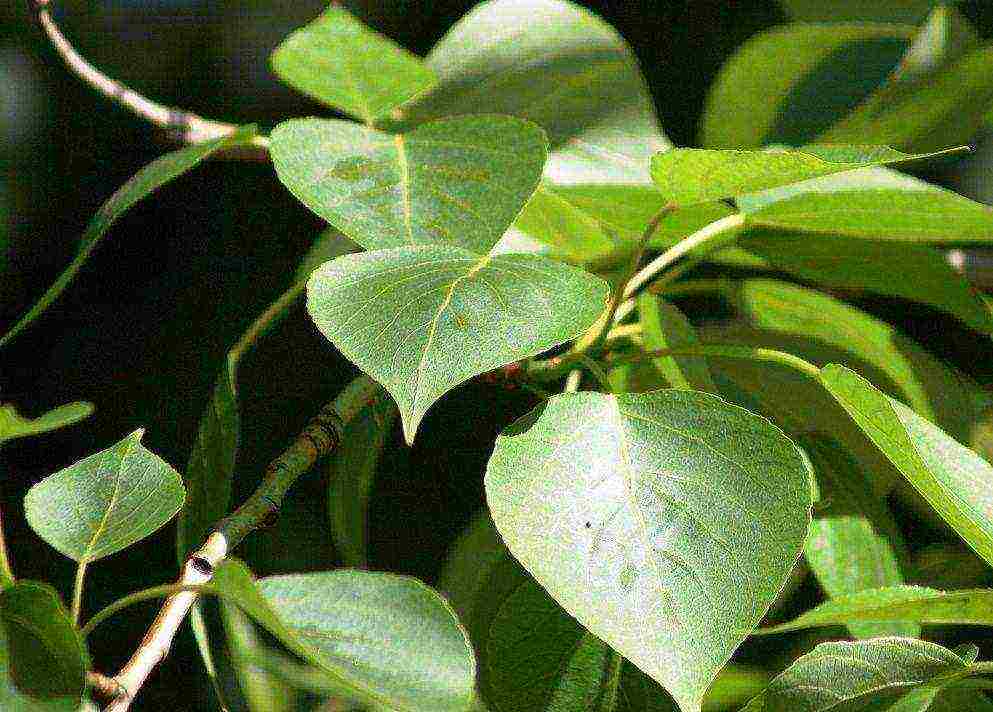
- Poplar is white. A plant of this species grows rather quickly, but only if the soil is fertile enough and well moistened. Over the course of a year, the tree grows about a meter in height and up to half a meter in width. It has a very powerful root system, which, depending on the amount of moisture in the ground, develops both on the surface and in the soil. Root suckers are more than abundant and thrive in wet soil. It is also popularly referred to as silver.
IT'S IMPORTANT TO KNOW!
Natural fertilizer that increases soil fertility ...

- Wild boar or black poplar. The roots of this garden plant are very well developed, they penetrate deep into the soil and at the same time, over time, they diverge several meters to the sides. The use of its individual components is quite extensive, because the plant belongs to the category of phytoncides. Therefore, they have the ability to kill almost all known microbes that are considered harmful to the human body. They also protect fruit trees such as pears and apple trees, which can also thrive in the immediate vicinity in the garden. In landscape design, it is used quite often, since it reproduces quite well with the help of root suckers. Reproduction by seeds is not recommended, since the percentage of their germination is quite low. It is possible to use other methods of reproduction.

- Italian. The landing site should be selected based on some signs, such as the occurrence of groundwater, the level of which must be at least four meters. Such varieties do not differ in particular winter hardiness, since they are able to withstand frosts down to -28 ° C, therefore, their level of winter hardiness is average. Like the white poplar Richardii, it grows up to forty meters, while the trunk diameter is about a meter.
With the seed method of reproduction, it should be borne in mind that the material very quickly loses its germination rates, therefore, all the necessary manipulations regarding their planting should be carried out as soon as possible. The spreading bushes of this plant help to clean the air from gas and dust. In addition, the poplar is extremely wind-resistant, so the landing site can be any, even open. To avoid the formation of fluff, it is recommended to plant males.
Cultivation and reproduction of poplar
A special description of the poplar is not needed, because a representative of this species can be found in almost every garden or yard. Its application is quite extensive, but unlike the Chinese one, it can be grown in our region. There are only two ways to reproduce poplar: cuttings and seeds.
When using the seed method
This method is fraught with a number of difficulties, therefore it is used extremely rarely. If, nevertheless, it was decided to breed poplar with seeds, it will be necessary to use fresh raw materials (collected independently) or already stratified in the nursery. If the collection of seeds was carried out independently, then germination or planting should be carried out in the coming days, since the level of their germination becomes lower every day.
When buying prepared seeds, germination is carried out in a small container with specially prepared soil. Before planting a seed, it must go through a stratification process without fail. The first shoots should appear after a few months; it makes no sense to wait longer.

Using the grafting method
Before choosing a seedling, you should check its roots for the presence of specific plaque, mold and stains, which would indicate improper care of a young plant. The rooting process is fast and should not cause any difficulties, but we are talking only about healthy seedlings. For germination, a container with a small amount of water or moist soil is used.When self-harvesting, only annual shoots, as the thinnest branches, are subject to cutting. For a year, the sprout can grow up to 25 cm.
SENSATION!!
The easiest way to save gas by 25% - 50% less ...
Planting young trees in the ground should be done with the onset of the first warm spring days. Planting is carried out in wet soil, while the distance between the holes should be at least 20 cm. Only a third of the appendage should be visible above the ground. Watering in the early years should be regular and abundant (it is better to avoid stagnant water). Already with the onset of autumn, cuttings can be planted in a permanent place.
Plant care
The distance between the holes when planting poplar varieties such as Soviet or Turkestan should be at least 3.5 m. The root system of this tree is very extensive and for proper development it will need a lot of free space. The hole will be less than a meter deep.
A plant of the large-leaved Aurora type loves fertile soils (the presence of sand, peat and sod soil in it), therefore, if there are none, additional and regular fertilization will be needed. If a heavy type of soil prevails on the site, then it is recommended to take care of a high-quality drainage layer. Varieties such as the Ontarian are extremely light-requiring, so it is recommended to give preference to well-lit areas.
As fertilizers, mixtures are used, which include nitrogen components. Additionally, nitroammophoska is used, which will need about 100 g per square meter. Watering should be abundant. At the bottom of the hole, about 30 liters of water is poured one-time. 2-3 waterings per month are considered sufficient; during a drought period, this should be done more often.
After the snow melts, near the hole, it is necessary to pierce the soil, which will avoid possible stagnation of moisture in the future. The depth of punctures will be no more than 15 cm. Similar manipulations should be carried out in the fall, before the onset of the first cold weather. Young roots are insulated with fallen leaves or cut grass. After planting, the site is mulched using sawdust and peat.
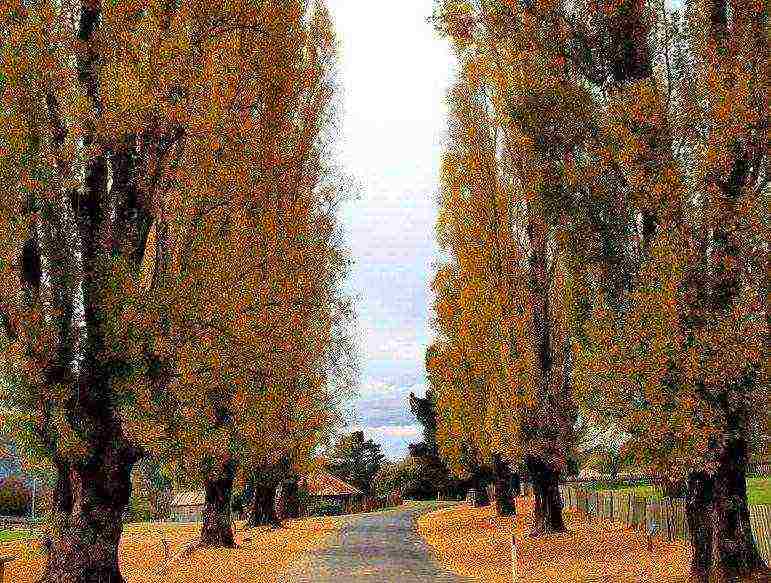
The plant does not need special preparation, since it tolerates frost extremely well. Sanitary and routine pruning is mandatory and is done several times a year. Garden putty will be needed to treat fresh wounds left after the pruner. For pruning, 2/3 of the length of the branch is counted. The shape of the crown should be even and this should be monitored. If necessary, additional shaping pruning is carried out, but only in the second year of the young plant's life.
Early spring and winter are perfect for pruning. All procedures must be carried out either before the start of sap flow, or after it. For rejuvenation, only the upper part of the tree is removed - the top. After pruning, the plant needs good feeding. The soil near the trunk is dug up and watered abundantly. New shoots need to be removed in a timely manner, otherwise, in a few years, the number of plants will increase significantly.
Poplar planting and its pests
Poplar can be found in almost every city in our country. There are several varieties of this plant, but no special differences are observed. Each of the varieties is used in landscape design. They are especially popular in densely populated cities, as they are able to purify the air from gases and dust.
However, all plants of this species are distinguished by excellent frost resistance, which allows them to be planted in any region. Foliage falls by November. The tree has many pests and almost all of them are very dangerous for its bark. That is why regular preventive work should be carried out aimed at the timely removal of pests. The necessary tool can be purchased at any store.
The main pests and diseases:
- insects that feed on young foliage;
- woody crayfish;
- necrosis.
The process of planting poplar is very scrupulous, although at first glance it seems very easy. To achieve the most optimal result, it is better to plant not in autumn, but in spring.
It is recommended to take care of a high-quality drainage system, which is located at the bottom of the hole. For its arrangement, you can use construction waste. The cervix is deepened to a certain depth (information provided by the local nursery). Depending on the type chosen, the distance between the holes will vary. The ability of a young tree to take root in a new place and the speed of its further growth will directly depend on this.
For the first few years, a young plant must be watered efficiently and regularly. Every year the soil needs to be loosened, and this should be done very carefully. After all, small roots, which are practically on the surface, are very easy to damage. Most gardeners recommend sowing the surrounding area with lawn grass, thereby not only insulating the root system, but also improving the decorative qualities of the garden plot.
Poplar
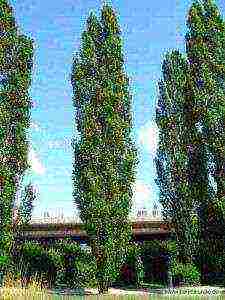 large dioecious trees up to 40 m high, with small flowers collected in earrings, which appear before the leaves begin to bloom or simultaneously with them. The fruit is a capsule with small seeds, equipped with bunches in the form of a bunch of hairs (“poplar fluff”). During the dispersion of seeds, fluff in large quantities is in the air, clogging everything around. Therefore, when using poplars in landscaping, planting female specimens should be avoided. For vegetative propagation, ONLY MALE plant specimens should be used.
large dioecious trees up to 40 m high, with small flowers collected in earrings, which appear before the leaves begin to bloom or simultaneously with them. The fruit is a capsule with small seeds, equipped with bunches in the form of a bunch of hairs (“poplar fluff”). During the dispersion of seeds, fluff in large quantities is in the air, clogging everything around. Therefore, when using poplars in landscaping, planting female specimens should be avoided. For vegetative propagation, ONLY MALE plant specimens should be used.
Poplar pyramidal - A slender tree up to 30 m tall, with a very narrow, columnar crown, covering the trunk of a free-standing tree from the ground. Due to the abundance of this species in the culture of Italy, it is often called "Italian" or "Lombard poplar". Morphologically (except for the shape of the crown) it differs little from the black poplar, but ecologically - very much. The leaves are rhombic or triangular (like that of the wild carp), but somewhat smaller; leafing and flowering occurs earlier than in black poplar; leaf fall - in late October - early November, so the growing season is longer and frost resistance is lower.
In culture, there are mainly male specimens (female ones are found in the cities of the Lower Volga region). Longevity in urban plantings depends on habitat conditions. A very spectacular tree in single, group, ordinary and alley plantings. Its monumental, pyramidal, dark green crown gives a special, southern character to the landscape, resembling slender, pyramidal cypresses. Good for quickly building green defensive walls.
Black poplar - A large tree, up to 30 m high, with a powerful, wide, branched crown and a cylindrical trunk, the bark of which is smooth at first, gray, later blackening, with deep cracks. Young shoots are shiny, yellow or yellowish-gray, smooth, slightly edged. Leaves are rhombic or triangular, with a long thin tip at the top, dark green above and somewhat lighter below, finely obtuse-toothed along the edge, fragrant.
It is undemanding to soil conditions, it can grow on dry and relatively poor soils. It grows very quickly on the rich and humid 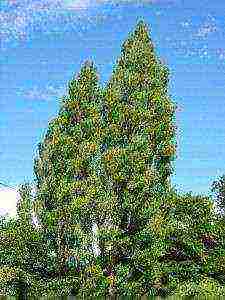 ... Winter-hardy and drought-resistant. Forms well. Relatively gas and smoke resistant. It is used in traditional landscape gardening.
... Winter-hardy and drought-resistant. Forms well. Relatively gas and smoke resistant. It is used in traditional landscape gardening.
Location: most poplars are very light-requiring. In nature, these are usually plants of river floodplains, but the experience of culture has shown that they can tolerate relatively dry, marginal soils; They are distinguished by an exceptional rapidity of growth, which is not found in other tree species of a temperate climate.
Planting: the distance between plants is 1.5 x 3 m or 2.5 x 4 m. The root system of poplars is deep and extensive, but there are many long roots on the surface. The depth of the pit is 0.8-1 m.The root collar is at soil level or buried by 1.5-2 cm. The soil mixture is prepared from turf, peat, sand (3: 2: 2). Better to plant in spring. With autumn planting, survival rate decreases. On heavy soils, drainage from construction waste, broken brick, sand is required. They fill 1/3 of the depth of the pit. When planting, nitroammofoska or kemira-wagon is introduced at the rate of 100 - 120 g per 1 m2.
Care: it is necessary to water so that the soil is soaked to the depth of the roots, 20 - 25 liters for each plant. In the first year of planting, watered two to three times a month, as well as during the dry season. To preserve moisture in the soil, the trunks are loosened after each watering. In the spring and autumn, bayonetting to a depth of 10-15 cm is required. After six to eight years, loosening can be stopped, and the trunks near the trees can be sown with a lawn. It is desirable to mulch with humus, peat or sawdust immediately after planting and watering. Poplar trees lend themselves well to cutting and pruning and easily restore the crown. Immediately after any trimming, all wounds with a diameter of more than 2.5 cm must be covered with garden putty or painted over with oil paint on natural drying oil. Pruning should be started at an early age and done annually. Cut off 2 / ^ of the length of the shoot, leaving 10-20 cm on the tree. The shape of the crown should be even, without protruding shoots. Heavy pruning is carried out in winter or early spring, before the start of sap flow. A powerful growth is formed from the stump, which should then be formed. When plants are rejuvenated, only the tops are cut, that is, about 10 - 15% of the height. After heavy pruning, fertilizer must be applied, watering and loosened on a regular basis. Shelters are not required for the winter. Frost resistant.
Protection against diseases and pests: poplar gall beetle. Systemic insecticides are effective against galls. Poplar-spruce aphid - spraying with karbofos is recommended. Poplar moth - in case of mass appearance of caterpillars, organophosphate insecticides are used. Rust. Colloidal sulfur helps against it, as well as against scab.
Links to the description of woody - ornamental plants
